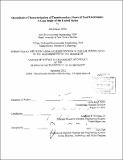| dc.contributor.advisor | Randolph E. Kirchain, Jr. | en_US |
| dc.contributor.author | Miller, Travis Reed | en_US |
| dc.contributor.other | Massachusetts Institute of Technology. Technology and Policy Program. | en_US |
| dc.coverage.spatial | n-us--- | en_US |
| dc.date.accessioned | 2013-04-12T19:29:46Z | |
| dc.date.available | 2013-04-12T19:29:46Z | |
| dc.date.copyright | 2012 | en_US |
| dc.date.issued | 2012 | en_US |
| dc.identifier.uri | http://hdl.handle.net/1721.1/78497 | |
| dc.description | Thesis (S.M. in Technology and Policy)--Massachusetts Institute of Technology, Engineering Systems Division, 2012. | en_US |
| dc.description | Cataloged from PDF version of thesis. | en_US |
| dc.description | Includes bibliographical references (p. 111-114). | en_US |
| dc.description.abstract | Despite growing interest and concern surrounding transboundary movements of used electronics around the world, there is a dearth of data on their movements. Although a multitude of different data sources exist, coherent sets of information on used electronics and their movement are lacking because of inherent challenges in obtaining such information. In spite of these challenges, a characterization of the sources, destinations, and quantities of used electronics flows would inform strategic decision-making of numerous stakeholders. A variety of approaches were reviewed for their potential to form a comprehensive quantitative characterization of used electronics generation, collection in the United States and export from the United States. First, the sales obsolescence method was selected to stochastically estimate the generation of used electronics. Collection rates were modeled and applied to the generation results; the collection results serve as upper bounds on export estimates. The export approaches chosen are applicable to all used electronics product types and give insight into the destinations of the exports. Despite concerns about the reliability of export trade data, the trade data approach was selected because of the abundance of available data for recent decades. The Bayesian Truth Serum Survey of Used Electronics Processors approach was selected for its ability to inform quantitative and qualitative characterizations with moderate effort. Comprehensive datasets were not as available for more reliable approaches. The generation and collection approaches were applied to the case of used laptop computers in the United States in 2010. Approximately 22 million laptops were generated and 12 million used laptops were collected. Uncertainty parameters were modeled for each estimate. Additional data sources, such as owner surveys, are necessary to create quality estimates of other types of used electronics since data is less available. The results of the two export approaches diverged. The trade data approach is believed to provide an underestimate, and resulted in a mean estimate of 0.9 million exported used laptops. The results of the survey, combined with collection estimates, resulted in an estimate of 6.0 to 12.0 million exported used laptops. | en_US |
| dc.description.statementofresponsibility | by Travis Reed Miller. | en_US |
| dc.format.extent | 123, [3], 28 p. | en_US |
| dc.language.iso | eng | en_US |
| dc.publisher | Massachusetts Institute of Technology | en_US |
| dc.rights | M.I.T. theses are protected by
copyright. They may be viewed from this source for any purpose, but
reproduction or distribution in any format is prohibited without written
permission. See provided URL for inquiries about permission. | en_US |
| dc.rights.uri | http://dspace.mit.edu/handle/1721.1/7582 | en_US |
| dc.subject | Engineering Systems Division. | en_US |
| dc.subject | Technology and Policy Program. | en_US |
| dc.title | Quantitative characterization of transboundary flows of used electronics : a case study of the United States | en_US |
| dc.type | Thesis | en_US |
| dc.description.degree | S.M.in Technology and Policy | en_US |
| dc.contributor.department | Massachusetts Institute of Technology. Engineering Systems Division | |
| dc.identifier.oclc | 836774230 | en_US |
